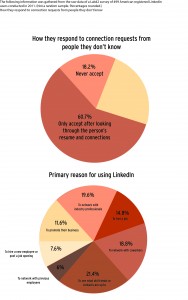Networking opportunities through LinkedIn mean that the most direct path to your dream job is probably not a straight line from your resume to an employer’s inbox.
LinkedIn may have been seen as just a business-class version of Facebook, but its primary function as a professional networking tool means that effective users approach it in an entirely different way, often with specific career goals in mind.
Scott Greenhalgh, manager of BYU Alumni Career Services, has been advocating networking for 25 years. According to Greenhalgh, 60-80 percent of jobs were found by networking when he began his career, and the statistic is the same today.
“So while the whole world has turned around (in that time), networking has not,” Greenhalgh said.

Greenhalgh sees Facebook’s purpose as socializing and LinkedIn’s as networking. LinkedIn has some social features, such as discussion boards within groups, but Greenhalgh personally doesn’t use them — despite being the owner of the official BYU alumni group.
“In my opinion, the mistake people make on LinkedIn is they try to use it like Facebook,” Greenhalgh said. “(Connecting with friends) should be where they start, but the problem is they limit themselves too much. … If you reach out to (other) people you have an affinity with you’ll find many, many more contacts.”
There are 74 million LinkedIn users in the United States and 200 million total. Information technology is the largest industry represented on LinkedIn, with four million users. The next largest fields are financial services, with 2.03 million users, and higher education, with 1.95 million users, according to the company blog.
Greenhalgh has a clear philosophy about the purpose of networking.
“The objectives of networking are to find people doing what you want to do, where you want to do it (and) seek advice about finding helpful, gainful employment,” he said.
But Greenhalgh pointed out that using LinkedIn is more about getting information about an area of interest than it is about finding a job directly.
“When you’re networking, it’s kind of against the rules to say, ‘Help me find a job,’” Greenhalgh said. “But ultimately that’s what you’re trying to do — find people who can help you with your career goals.”
Jordan Fowles, a corporate counsel at Google and a BYU-Idaho alumni mentor, shares Greenhalgh’s philosophy about networking.
“As a BYU-Idaho alumni mentor, I can’t say that I’ve gotten any students a job,” Fowles said. “But I have helped connect them to people in fields they are interested in so that the student can discuss what that career space is like with someone who actually works in it.”
Those discussions can lead to employment, Fowles said. However, LinkedIn is helpful beyond just getting a job.
A LinkedIn network is helpful to students considering employment offers who want information about where they’d be living, Fowles said. When he was looking into taking his job with Google, Fowles used his LinkedIn network to get introductions to Google employees and talk to them about what it was like to move to the area.

Matthew Kolar is a human resources student who has used LinkedIn to facilitate informational interviews instead of job interviews.
“(They allow me to) learn more about the organization, industry and (its) culture, and establish a relationship with a potential mentor,” Kolar tweeted.
LinkedIn allows organizations to post job openings, so using it as a job listing website can be effective also.
BYU alumnus Reza Ghazimoradi graduated in geographical information systems in 2004 and used LinkedIn to look for jobs while he was living in Washington, D.C. He found a position that fit his resume and heard back from a recruiter the morning after he applied. After further communication with the recruiter, he moved to Texas to take a job as an international logistics analyst for Easton-Bell Sports.
Now as the employment specialist in his ward, one of the first things he does with people is encourage them to update their LinkedIn profile.
Some students and alumni prefer not to focus on getting a job through LinkedIn, but they still use LinkedIn to supplement their efforts.
Tyler Aston, an information systems teaching assistant, doesn’t expect his LinkedIn profile to help him find a job. Rather, he uses it to build his credibility should potential employers look him up.
Aston also uses a free LinkedIn-affiliated application called CardMunch. When users snap a photo of a business card, a LinkedIn employee digitizes the content and adds it to the user’s contact list.




